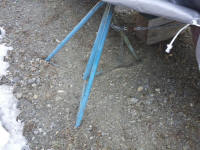
110 Cookson Lane | Whitefield, ME 04353 | 207-232-7600 | tim@lackeysailing.com
Spectre | Monday, March 3, 2014 to Saturday, March 8, 2014
It had been, and continued to be, a cold winter, with temperatures mostly remaining below freezing during the days and much colder at night, and plenty of snow and ice--all punctuated by just enough warmer, above-freezing weather and rain to ensure that the ground and all snow banks became well-saturated with water, so that everything became particularly hard and icy when the temperatures got colder again.
Spectre was delivered to the shop last summer in my absence, and during a busy period at the shop, and the transporter didn't install any plywood pads beneath the jackstands. Naturally I noticed this at the time, but I didn't ever get around to correcting the issue. So the net result of this, exacerbated by freeze-thaw cycles, was that the stands became well-sunken into the ground beneath the boat.
During a couple days of warmer weather a few weeks earlier, and anticipating the beginning of the project soon, I'd taken advantage of the thaw and removed a large snow pile from in front of the boat, and also from around the boat and stands. This exposed the bases, and most or all of the snow and ice on the surface melted away. But the bases remained well frozen into the ground, though I did manage to release and reposition one of the forward three stands during this period. I didn't worry much about the after pair of stands for now, as I could move the boat as long as I could move the forward three.
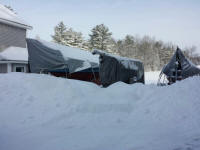
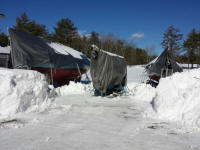
Now, a couple weeks later and ready to move the boat indoors and begin work, with very cold weather on hand (below zero at night and only in the teens during the day) I found it impossible to remove the remaining two stands from their icy earthen confines. I spent some time attempting to chip away the ground, with some success, but still couldn't get the stands to budge, and after some time of this I decided it was a poor use of my time and that it would be better to just wait a few days for the weather to warm up before making another attempt. The fact that the stands were short, and the boat low to the ground, didn't help, as it limited working space and leverage possibilities.
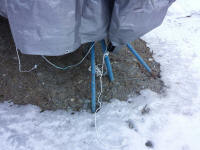
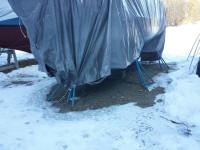
In addition, the boat's cover, which had been installed over a very flat and minimal framework, was full of ice and snow on one side--something that had already reached the point of no return by the time I noticed it during my early work preparing the boat for eventually moving into the shop. This I could eventually deal with, but it wasn't making the whole transport prospect any easier for the moment, and the huge plug of ice and snow was adding substantial weight to the boat.
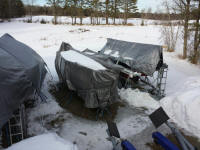
After several days' wait, the mid-day temperatures finally climbed over the freezing mark on Friday, and, with additional effort, I was able to free the forward center stand and the starboard forward stand from the frozen ground, which was enough for me to get the trailer beneath. It would have been better if I could have moved the after stands, but I couldn't get those at this point, so I perched the boat well aft on the trailer, which was good enough to move her out more into the open.
I found the boat was extremely unbalanced thanks to the weight of the massive amount of ice on the starboard side, and I knew I'd have to reset her on the trailer before putting the boat in the shop, so since it was late in the day, once she was in the open I reblocked her for the night, using additional stands and even the trailer's pads for additional support overnight. There was no way to remove the ice from the cover, as it was too large, too heavy, and too dangerous to try, so I'd have to get the boat indoors and let the ice start to melt.
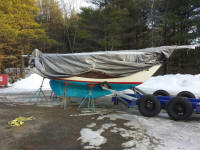
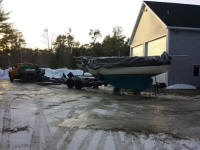
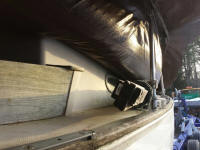
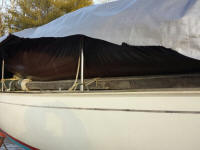
In the morning, I repositioned the boat on the trailer in a much more satisfactory way, and moved her into the shop, again well aware of the extra weight and unbalance caused by the ice. By the end of the day, water was dripping, but it'd take some time for this volume of ice to melt enough to the point that I could remove the rest, and the cover. That icy plug--covered with some snow--was about 2+ feet deep, a couple or three feet wide, and about 15 or 20 feet long, running from the bow pulpit to the aft end of the cockpit. It had depressed the unsupported cover to the point that the ice rested on the decks inside of the lifelines (removal of the lifelines was this project's main focus, ironically).
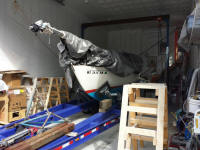
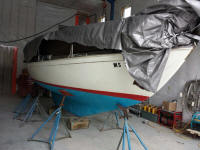
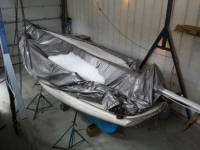
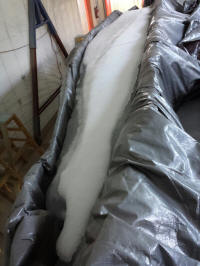
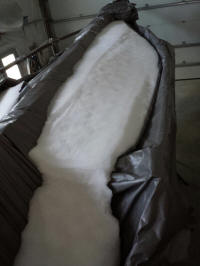
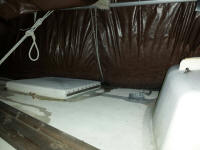
Total Time Billed on This Job Today:
4
Hours
